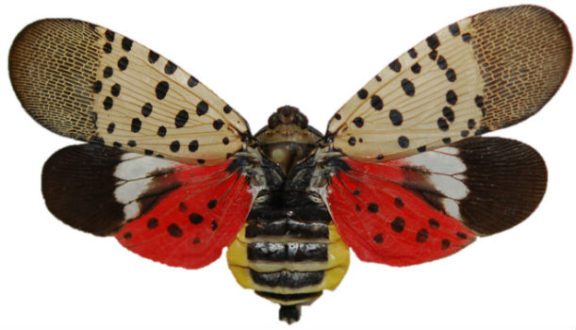Oct 1, 2018Spotted lanternfly on Washington invasive species priority list
The adult spotted lanternfly is a sight to behold; its wings are a tapestry of inky spots and delicate stripes underscored with broad patches of bold crimson. Its plump body is reminiscent of a bumble bee or a cicada.
But Washington State Department of Agriculture’s (WSDA) Plant Protection entomologists see this colorful bug as a big threat to Washington’s tree fruit and grape industry. They are gearing up to try to block the road for this insidious hitchhiker and prevent fast-spreading infestations like those seen in Pennsylvania and Virginia.
WSDA’s Pest Program classifies the spotted lanternfly as a “target pest” in multiple pest surveys and earlier this month, the Washington Invasive Species Council added it to the likes of apple maggots, gypsy moths and brown marmorated stink bugs on its top priority species list.
A native of China, the spotted lanternfly first arrived in Pennsylvania in 2014 and quickly proved it is a pest to be reckoned with.
Entomologist Sven-Erik Spichiger spent a decade as Pennsylvania’s state entomologist before joining the WSDA Plant Protection team this year. He knows how bad the infestations can be from experience.
“When you’ve seen tens of thousands of spotted lanternflies on an apple tree during harvest, it will turn your head around,” Spichiger said.
He said from an insect scientist’s perspective, the lantern fly is fascinating.
“But for the public, one bug gets their attention. Imagine how they feel when they come out to their toddler’s swing set and find it coated with more than 200,000.”
The lanternfly spreads plant disease, weakens trees and threatens the country’s multi-billion dollar grape, orchard and logging industries.
And it’s just gross.
The spotted lanternfly lays eggs in non-descript gray globs that are difficult to detect on trees, rusty cans or park benches. It multiplies insidiously by the thousands and can overtake trees, and crops — even playground equipment – overnight.
Then there’s the “honey dew.” That’s entomologist talk for lanternfly urine. Lanternflies feed on sap and excrete sticky droplets of sugar-rich urine that rain down from infested trees so hard in some cases, people need rain coats to work in the area. The shellac of honey dew turns rancid over time and attracts swarms of bees, ants, and wasps. Finally, the coated understory becomes black with “sooty mold.”
In Pennsylvania, the infestation continues to spread, despite more than $20 million poured into research and eradication efforts this year alone. Lanternflies have now invaded Virginia, New Jersey, and Delaware.
These prolific bugs suck sap from hardwood trees, grape vines and fruit trees but its favorite food is the Ailanthus tree or “tree of heaven.” Spichiger says the tree of heaven – another invasive species – grows in disturbed areas such as vacant lots, highway medians and especially along railroad lines.
“Train tracks are lined with these trees,” he said, pointing out that one of the big concerns here in Washington is that this pest is an active hitchhiker.
“All it takes is a stiff wind to knock one of these into a rusty box car and the next week it’s on the West Coast,” Spichiger said. “There is a very high likelihood that this will continue spreading.”
Although there is plenty of reason for concern, Spichiger said there is also hope.
Treatments that combine host removal with pesticide applications have been shown to be effective on small infestations, he said. And because of its distinctive appearance, engaging the public to help locate infestations can be effective.
“Control strategies work best when entomologists have ability to rapidly respond to the pest,” he said. “You can actually control lanternfly infestation using this strategy if you detect them early,” Spichiger said.
For more information about WSDA’s Pest Protection Program.
– Chris McGann, WSDA Communications















